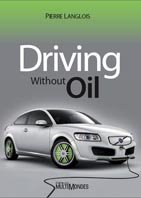
Illustration - Representation of a wheel-motor similar to those developed by the team of Pierre Couture at Hydro-Québec and presented to the public in 1994. The author of this blog has drawn it from public information contained in the promotional materials and patents.
Quebecers over 30 years old remember seeing on television in 1994 and 1995 a revolutionary experimental car equipped with high performance electric wheel-motors. It was a Chrysler Intrepid transformed by researchers from Hydro-Quebec, under the direction of Dr. Pierre Couture, a brilliant physicist ahead of its time, the main inventor of this power train, unmatched so far. The press conference to announce this brilliant technology took place on December 1st, 1994. To see the flyer distributed on that occasion click HERE, and to read the transcription in english of Pierre Couture’s speech explainaing the technology ckick HERE.
The basic idea was to convert the Intrepid in a plug-in hybrid car. By recharging the battery during the night at home, the owner of the car could travel 65 km (40 miles) in electric mode for each day without consuming fuel. For journeys longer than 65 km (40 miles), a small fuel engine activates a generator to recharge the battery while driving, giving the car a range similar to that of a traditional car. This is what we call today a series hybrid vehicle, whose fuel engine is not mechanically connected to the wheels. Furthermore, since 80% of people drive less than 65 km (miles) per day with their car, on average, the vast majority of their mileage would be done with electricity.
It is this concept that is used by GM in its Chevy Volt, which should be commercialized in 2011. However, the Chevy Volt is not equipped with wheel-motors, but with a central electric motor under the hood. This makes the car heavier and more expensive, while consuming more electricity and leaving less space available for the passengers and the trunk.
Unfortunately, in 1995 Hydro-Quebec has taken a completely incomprehensible decision to significantly reduce its proposed development of Couture’s power train, which led to the resignation of its inventor in 1995. Pierre Couture has never worked on this project since. The TM4 company, a subsidiary of Hydro-Québec, which was set up to commercialize the Couture power train with 4 wheel-motors, hence its name (Technology Motor 4 “wheels”), has stopped working on the high power wheel-motor for all practical purposes and works now mainly on central electric motors, like everyone else.
The author of this blog is absolutely convinced that the wheel-motor power trains, similar to the one developed by Pierre Couture, are the best and will be the power trains of the future. Here's why.
First, looking at the illustration above, we find that the permanent magnets (green and orange) are fixed near the rim of the wheel, giving the motor a large diameter, which increases its torque and power. There are of course other innovations designed by Pierre Couture that contribute to its high efficiency (above 96%), with a power greater than 100 kW (134 hp) and a torque of 1200 N.m (885 lbs-ft) for each motor, which was 2.5 times more than a Corvette engine of the time! The total power with 4 wheel-motors would have exceed 400 kW and the total torque 4800 N.m, which would have propel the Chrysler Intrepid from 0 to 100 km / h (0-60 mph) in 3 seconds, according to calculations by Pierre Couture!
The performance of these wheel-motors have been tested in the laboratory, but at the time of the resignation of Dr. Couture, only 2 wheel-motors were installed on the Intrepid and the power electronics was not yet complete, hence the impossibility to have full testing on the road. However, the illustration below shows a field test where the two motorized wheels were spinning while remaining on the spot and burning rubber. This performance was simply not possible with the V8 engine of the original Chrysler Intrepid.

Illustration - Images from the TV program Découverte broadcasted by Radio-Canada in 1997. (Photo: Archives of Radio-Canada)
The goal of having such powerful motors was not to race but to recover more of the car kinetic energy when braking, even suddenly. With four wheel-motors and good batteries we can recover nearly 90% of the kinetic energy since the four motors act as four powerful electromagnetic brakes that produce electricity to recharge the battery. This is called regenerative braking. In traditional cars, the kinetic energy is lost in heat in the mechanical brakes. Now, in an electric car with a central motor, we can only recover 20% to 25% of the kinetic energy when braking. This is because the electric motor is connected to two wheels only, while we must have four brakes, and because the motor being located behind a differential we must have mechanical brakes even on the two motorized wheels. Otherwise if one wheel is on ice, the driver could lose control of the car.
Moreover, with four wheel-motors, there is no differential neither transmission. It is a direct drive, and there is no energy loss between the motor and wheels, as in a car with central engine. This is a second reason why wheel-motors consume less energy, particularly during cold winters.
Moreover, since energy consumption is lower, we can reduce the size of the battery, engine-generator and fuel tank. Besides the wheel-motors themselves are lighter than a central electric motor of equivalent power, since their external structures fulfill a dual function, serving also to support structure to the wheels. The reduction of the car weight is therefore a third cause of reduction in energy consumption.
Now, the fact that with wheel-motors there is no motor under the hood allows us to taper the front of the car and close the underside. These changes improve aerodynamics and provide a fourth contribution to reducing its energy consumption.
These four factors combine to give an energy consumption in urban driving about 35% less than a car having a central electric motor, and about 15% lower when driving on the highway. In mixed driving, we obtain a reduction in consumption of around 25% with four wheel-motors. THIS IS A BIG DIFFERENCE, ESPECIALLY FOR URBAN CARS, TRUCKS AND BUSES! This reduced energy consumption affects not only the operating cost of vehicles but also the purchase cost, since the battery (very expensive) and the engine (for plug-in hybrids) can be scaled down considerably. Moreover the wheel-motor vehicles have significantly less parts (no differential, no transmission, no cardans, no ABS braking hardware).
BESIDES, NOT ONLY THE WHEEL-MOTOR CARS ARE THE MOST ENERGY-EFFICIENT BUT THEY ARE ALSO THE MORE POWERFUL, WHICH IS REALLY A PARADIGM SHIFT. James Bond and Al Gore could carpool together in a wheel-motor car and the two would be very happy!
In closing, it would be good to mention four other advantages of wheel-motors that are not related to energy consumption or power. The fact that there is no engine under the hood increases the crush zone of the metal during a frontal impact, improving the safety of passengers. Furthermore, the lack of engine under the hood gives more flexibility to the car designers. Also, with four wheel-motors, we can incorporate an anti-skidding system and an ABS braking system only by software. Finally, the driver has a four-wheel drive vehicle, which is quite popular in winter in the nordic countries, and well appreciated by those who drive off-road.





This is indeed a very wonderful idea !!
ReplyDeleteIs there any patent over the invention?
Anyone?
I understand the main argument against in-wheel motors is that it makes the wheels too heavy. This makes the wheels have trouble sticking to the road properly and makes the car handle poorly. Car people call this "unsprung weight". This is the reason Tesla avoided in-wheel motors for their EVs.
ReplyDeleteI brought this up several months back with a friend of mine who works at Tesla and has a lot of experience designing cars. He said the main problems with in-wheel motors are that it add a lot to the unsprung weight which negatively affects how well the vehicle handles. Think what happens when a wheel travels over uneven pavement (a very common occurance around here). The wheel will move up and down with the springs and shocks keeping the wheel against the pavement while the body of the car moves far less. With the extra mass and rotational inerta in the wheels it takes a lot more force to keep the wheel against the pavement and a lot more of the bumps will be transferred to the body of the vehicle, making for a more jarring ride where the car loses traction on uneven pavement. The rotational inertia of the wheels is also not so desireable if one thinks of the gyroscopic effects.
ReplyDeleteAnother problem is that it adds a lot of complexity and cost to the control system to drive all of the wheels in various conditions (like applying power evenly while cornering when the wheel speeds do not match). The inverter used to drive the motor would also have to be replicated for each wheel, adding additional cost and complexity.
Also, standard brakes are required regardless of wheel motors or no. It would help with the unsprung weight if the brakes were not in the wheels, but for safety the brakes must be located as close as possible to the wheels.
Another problem that comes up is how to cool the motor and keep dirt out of it. Having the motor in the body makes it much easier to do this with either air or liquid cooling.
From a safety perspective having high voltage power running to the wheels presents a big problem as well, along with the possibility of those wires becomming damaged for frayed. Keeping it entirely within the body of the vehicle is a lot safer.
Most braking power is also applied to only the front wheels, and it is still possible to use two motors, one for the front and one for the back with differentials if more regenerative braking is required. Another alternative is to provide all-wheel drive with a single motor.
It's a lot cheaper to have one motor than four motors as well. Plus gearing can be used so torque is not an issue so a higher speed lower torque motor can be used.